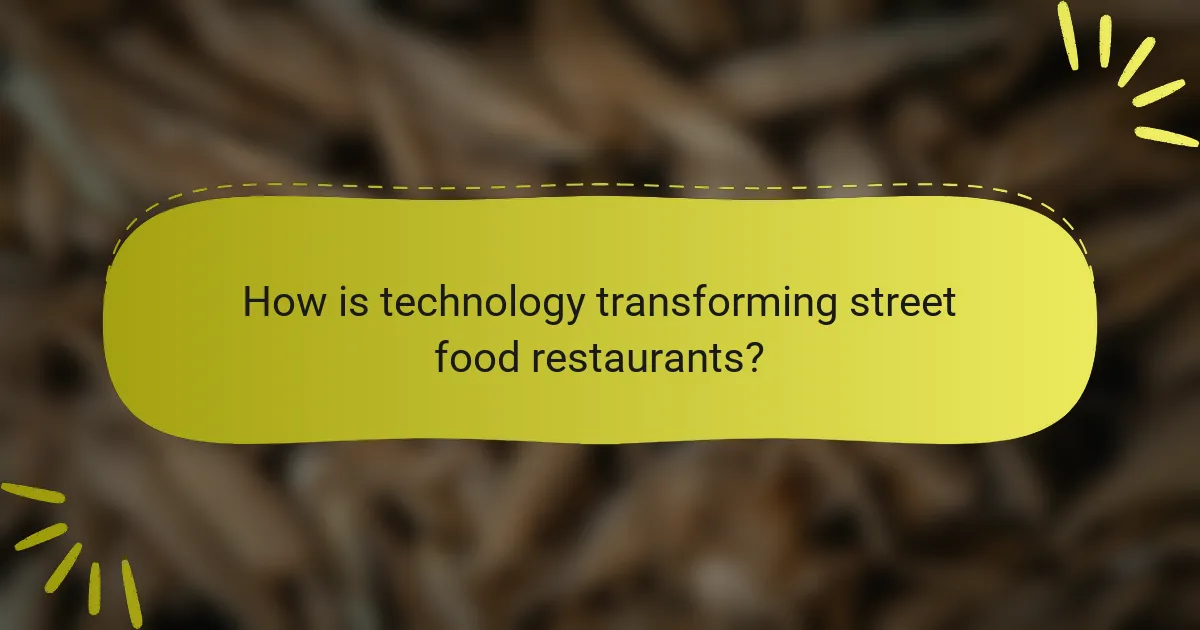The article examines the future of street food restaurants, focusing on current trends, technological advancements, and evolving consumer preferences. Key trends include a strong emphasis on sustainability, with vendors adopting eco-friendly practices and offering plant-based options. The integration of technology, such as mobile ordering and digital payment systems, enhances customer experience and operational efficiency. Additionally, the article highlights the growing popularity of diverse global cuisines and fusion dishes, driven by adventurous eaters seeking unique flavor profiles. Understanding these trends is crucial for stakeholders in the street food industry to adapt and thrive in a changing market landscape.

What are the current trends in street food restaurants?
Current trends in street food restaurants include a focus on sustainability, diverse global cuisines, and technology integration. Sustainability is driving the use of eco-friendly packaging and locally sourced ingredients. Many street food vendors are offering plant-based options to cater to health-conscious consumers. Global cuisines, especially fusion dishes, are gaining popularity, attracting adventurous eaters. Technology is enhancing customer experience through mobile ordering and payment systems. Additionally, social media marketing plays a crucial role in promoting street food. According to a 2023 report by Food & Beverage Trends, 75% of consumers prefer street food that incorporates innovative flavors and sustainable practices.
How are consumer preferences shaping these trends?
Consumer preferences are significantly influencing trends in street food restaurants. Increasing demand for healthier options is prompting vendors to offer more nutritious ingredients. Many consumers now prioritize sustainability, leading to a rise in eco-friendly packaging and sourcing practices. The popularity of diverse cuisines is driving street food vendors to experiment with fusion dishes. Convenience also plays a crucial role, as consumers favor food that is quick to prepare and easy to eat on-the-go. Social media trends are shaping menu items, as visually appealing dishes attract more customers. Data indicates that 70% of consumers prefer brands that reflect their values, underscoring the importance of aligning offerings with consumer expectations. These shifts illustrate how consumer preferences directly shape the evolution of street food restaurants.
What specific types of cuisines are gaining popularity?
Plant-based cuisines are gaining popularity. This trend reflects a growing demand for healthier and sustainable food options. Asian fusion cuisine is also on the rise. It combines elements from different Asian cultures, appealing to diverse palates. Mexican street food has gained traction due to its vibrant flavors and accessibility. Additionally, Middle Eastern cuisine is becoming more mainstream, with dishes like falafel and shawarma gaining fans. According to a report by the National Restaurant Association, 60% of consumers are interested in trying new cuisines. This data supports the trend of increasing culinary exploration among diners.
How is sustainability influencing street food offerings?
Sustainability is significantly influencing street food offerings by promoting eco-friendly practices and local sourcing. Street food vendors are increasingly adopting biodegradable packaging to reduce plastic waste. Many are sourcing ingredients from local farms to minimize carbon footprints. This shift supports local economies and fosters community engagement. Additionally, vendors are focusing on plant-based options, which have a lower environmental impact compared to meat. Research indicates that 63% of consumers prefer sustainable food options. This consumer preference drives street food vendors to innovate and adapt their menus accordingly. Ultimately, sustainability is reshaping the street food landscape by aligning offerings with environmentally conscious consumer values.
What role does location play in the success of street food restaurants?
Location significantly influences the success of street food restaurants. High foot traffic areas enhance visibility and customer access. Locations near tourist attractions or busy commercial districts attract more patrons. Proximity to public transportation increases convenience for customers. Local demographics also affect success; areas with a diverse population may yield varied customer preferences. Additionally, competition in the vicinity can impact sales; being unique in a crowded market is crucial. Research indicates that 60% of street food success is attributed to strategic location choices. This data underscores the importance of location in driving customer engagement and revenue.
How do urban areas impact street food culture?
Urban areas significantly shape street food culture through population density and diversity. High population density creates a larger customer base for street food vendors. This results in increased demand for quick, accessible food options. Urban areas also attract diverse populations, leading to a fusion of culinary traditions. This diversity encourages innovation in street food offerings. Additionally, urban environments provide platforms for food festivals and markets. These events promote street food visibility and popularity. Economic factors in urban areas can also influence pricing and vendor sustainability. Overall, urban areas foster a dynamic and evolving street food culture.
What factors contribute to the ideal location for a street food vendor?
The ideal location for a street food vendor is determined by several key factors. High foot traffic is essential, as it increases visibility and potential customers. Proximity to popular attractions, such as parks or events, can enhance customer engagement. Accessibility is also crucial; vendors should be easy to reach for pedestrians and vehicles.
Zoning regulations must be considered, as they dictate where vendors can operate legally. Competition with nearby food options can impact sales; vendors should assess the density of similar offerings. Seasonal factors, like weather patterns, can influence customer turnout.
Lastly, local demographics play a role; understanding the target market helps in selecting the best location. These factors collectively contribute to the success of a street food vendor.

How is technology transforming street food restaurants?
Technology is transforming street food restaurants by enhancing operational efficiency and customer engagement. Mobile apps allow customers to order food in advance, reducing wait times. Digital payment systems streamline transactions, making it easier for customers to pay. Social media platforms help vendors promote their offerings and connect with a wider audience. Online reviews and ratings influence consumer choices, driving quality improvements. Point-of-sale systems provide valuable sales data, aiding inventory management. Additionally, food delivery services expand market reach beyond physical locations. These advancements contribute to a more dynamic and responsive street food industry.
What technological innovations are being adopted by street food vendors?
Street food vendors are adopting various technological innovations to enhance their operations. Mobile payment systems are increasingly used, allowing for cashless transactions. This improves efficiency and customer convenience. Food safety technology, such as temperature monitoring devices, ensures compliance with health regulations. Many vendors employ social media for marketing and customer engagement. Online ordering platforms are also becoming popular, enabling pre-orders and reducing wait times. Additionally, GPS tracking helps vendors optimize their locations and reach more customers. Data analytics tools provide insights into customer preferences and sales trends. These innovations are transforming the street food industry, making it more competitive and customer-focused.
How are mobile apps changing the street food experience?
Mobile apps are transforming the street food experience by enhancing accessibility and convenience. They allow users to order food from vendors remotely. This reduces wait times and streamlines the purchasing process. Additionally, apps often provide real-time tracking of orders. Consumers can receive notifications when their food is ready. Many apps also feature user reviews and ratings. This helps customers make informed choices about where to eat. Furthermore, mobile payment options simplify transactions. This increases the likelihood of impulse purchases. Overall, mobile apps are reshaping how consumers interact with street food vendors.
What role does social media play in marketing street food businesses?
Social media plays a crucial role in marketing street food businesses. It enables these businesses to reach a broader audience quickly. Platforms like Instagram and Facebook allow for visual storytelling. Street food vendors can showcase their dishes through appealing images and videos. This visual content engages potential customers effectively. Social media also facilitates direct interaction with consumers. Vendors can respond to inquiries and gather feedback in real-time. According to a study by the National Restaurant Association, 70% of consumers are influenced by social media when choosing where to eat. This highlights the significant impact of social media marketing in driving customer decisions for street food businesses.
How does technology enhance food safety and quality in street food?
Technology enhances food safety and quality in street food through various innovative solutions. Food safety management systems utilize real-time data to monitor temperatures and hygiene practices. Mobile applications allow vendors to track food sourcing and expiration dates effectively. Advanced cooking equipment ensures that food is cooked at safe temperatures. Blockchain technology provides traceability of ingredients, enhancing consumer trust. Sensors can detect contaminants in food, alerting vendors to potential hazards. Regular training programs facilitated by technology improve vendor knowledge on food safety protocols. These advancements collectively lead to safer and higher quality street food offerings.
What are the best practices for using technology to ensure food safety?
Implementing technology in food safety involves several best practices. First, utilize temperature monitoring systems. These systems ensure food is stored and cooked at safe temperatures. Second, adopt digital inventory management. This practice helps track food freshness and reduces waste. Third, employ blockchain technology. Blockchain enhances traceability in the food supply chain. Fourth, use mobile apps for food safety training. These apps can provide real-time guidance to staff. Fifth, integrate IoT devices. IoT can monitor conditions in real-time, alerting staff to potential hazards. Each of these practices contributes to a safer food environment, minimizing risks associated with foodborne illnesses.
How can technology improve customer service in street food settings?
Technology can improve customer service in street food settings by streamlining operations and enhancing customer interaction. Mobile ordering apps allow customers to place orders in advance, reducing wait times. Digital payment systems facilitate quick transactions, enhancing convenience. Social media platforms enable vendors to engage with customers and promote their offerings effectively. GPS tracking allows customers to locate food trucks easily, improving accessibility. Customer feedback tools help vendors gather insights and improve their services. Data analytics can optimize menu offerings based on customer preferences. These technological advancements lead to a more efficient and satisfying customer experience in street food environments.

What are the future consumer preferences for street food restaurants?
Future consumer preferences for street food restaurants emphasize convenience, quality, and sustainability. Consumers increasingly seek quick service and easy access to food. They prefer high-quality ingredients and unique flavor profiles. Health-conscious options are becoming more popular among diners. Many consumers are also interested in plant-based and vegan offerings. Sustainability in sourcing and packaging is a growing concern for patrons. Technology integration, such as mobile ordering and contactless payments, is expected to enhance the dining experience. These preferences reflect broader trends in food consumption and lifestyle choices.
How are dietary trends influencing street food menus?
Dietary trends are significantly influencing street food menus by promoting healthier and more diverse options. Many street food vendors are now incorporating plant-based ingredients to cater to the growing vegan and vegetarian populations. This shift aligns with the increasing consumer demand for sustainable and ethical food choices. Additionally, gluten-free and low-carb options are becoming more prevalent on street food menus. This change reflects the rising awareness of dietary restrictions and health concerns among consumers.
Research indicates that 39% of consumers actively seek healthier options when dining out. Street food vendors are adapting by offering dishes that are lower in calories and higher in nutritional value. Furthermore, fusion cuisines are emerging as vendors blend traditional street food with global dietary trends. This not only attracts a wider audience but also keeps menus dynamic and appealing. Overall, dietary trends are reshaping street food offerings to meet evolving consumer preferences.
What impact do health-conscious choices have on street food offerings?
Health-conscious choices significantly influence street food offerings. Vendors are increasingly incorporating healthier ingredients. This shift includes organic produce and whole grains. Many street food options now feature plant-based proteins. Consumers are demanding lower-calorie and lower-fat meals. As a result, traditional fried items are being replaced with grilled or baked options. Studies show that 60% of consumers prefer healthier street food choices. This trend is reshaping menus to attract health-focused customers.
How are cultural influences shaping consumer expectations?
Cultural influences shape consumer expectations by defining preferences and behaviors. These influences include traditions, values, and social norms. For example, street food cultures vary globally, impacting what consumers expect in flavors and presentation. In countries like Thailand, consumers anticipate vibrant spices and fresh ingredients. In contrast, American street food often emphasizes convenience and fusion flavors. Research shows that 70% of consumers prefer culturally authentic experiences in dining. This expectation drives restaurants to adapt menus based on cultural trends. Consequently, street food establishments must align offerings with local cultural expectations to thrive.
What strategies can street food vendors use to adapt to changing preferences?
Street food vendors can adapt to changing preferences by diversifying their menu offerings. This includes incorporating vegetarian, vegan, and gluten-free options to cater to a broader audience. Vendors can also utilize social media to engage with customers and gather feedback on their preferences. By analyzing sales data, they can identify popular items and trends. Seasonal ingredients can be highlighted to promote freshness and sustainability. Collaborating with local farmers can enhance the quality and appeal of their food. Additionally, adopting technology for online ordering and delivery can meet the demand for convenience. These strategies help vendors remain relevant and responsive to consumer needs.
How can street food restaurants leverage feedback to improve their offerings?
Street food restaurants can leverage feedback to enhance their offerings by systematically collecting and analyzing customer input. They can use surveys, comment cards, and online reviews to gather this information. Analyzing feedback allows restaurants to identify popular menu items and areas needing improvement. For instance, 70% of consumers say they trust online reviews, highlighting their importance. Additionally, implementing changes based on feedback can lead to increased customer satisfaction and loyalty. Regularly updating offerings based on customer preferences can keep the menu fresh and appealing. This approach not only helps in retaining existing customers but also attracts new ones through positive word-of-mouth.
What are the key takeaways for future-proofing a street food business?
Diversifying menu options is crucial for future-proofing a street food business. This approach caters to evolving consumer preferences and dietary needs. Utilizing local and sustainable ingredients enhances food quality and supports community engagement. Implementing technology, such as mobile ordering and payment systems, streamlines operations and improves customer experience. Establishing a strong online presence increases visibility and attracts a broader audience. Adapting to health and safety regulations ensures compliance and builds customer trust. Engaging with customers through social media fosters loyalty and feedback. Regularly analyzing market trends helps in making informed decisions. These strategies collectively position a street food business for long-term success.
The main entity of the article is street food restaurants, which are evolving through current trends, technological advancements, and changing consumer preferences. Key topics include the emphasis on sustainability and health-conscious options, the rise of diverse global cuisines, and the integration of technology to enhance customer experience and food safety. The article also explores the impact of location on street food success, the role of social media in marketing, and strategies for vendors to adapt to shifting consumer demands. Overall, it provides a comprehensive overview of how these factors are shaping the future landscape of street food.